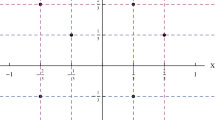Abstract
We study the spectrum of the Laplacian on the Sierpinski lattices. First, we show that the spectrum of the Laplacian, as a subset of \({\mathbb {C}}\), remains the same for any \(\ell ^p\) spaces. Second, we characterize all the spectral points for the lattices with a boundary point.







Similar content being viewed by others
References
Bajorin, N., Chen, T., Dagan, A., Emmons, C., Hussein, M., Khalil, M., Mody, P., Steinhurst, B., Teplyaev, A.: Vibration modes of \(3n\)-gaskets and other fractals. J. Phys. A 41(1), 015101 (2008)
Bajorin, N., Chen, T., Dagan, A., Emmons, C., Hussein, M., Khalil, M., Mody, P., Steinhurst, B., Teplyaev, A.: Vibration spectra of finitely ramified, symmetric fractals. Fractals 16(3), 243–258 (2008)
Bauer, F., Hua, B., Keller, M.: On the LP spectrum of Laplacians on graphs. Adv. Math. 248, 717–735 (2013)
Barlow, M.T., Perkins, E.A.: Brownian motion on the Sierpiński gasket. Probab. Theory Relat. Fields 79(4), 543–623 (1988)
Bockelman, B., Strichartz, R.S.: Partial differential equations on products of Sierpinski gaskets. Indiana Univ. Math. J. 56(3), 1361–1375 (2007)
Chen, J.P., Teplyaev, A.: Singularly continuous spectrum of a self-similar Laplacian on the half-line. J. Math. Phys. 57(5), 052104 (2016)
Davies, E.B.: \(L^p\) spectral independence and \(L^1\) analyticity. J. Lond. Math. Soc. 52, 177–184 (1995)
Davies, E.B.: Linear Operators and Their Spectra. Cambridge Studies in Advanced Mathematics, vol. 106. Cambridge University Press, Cambridge (2007)
DeGrado, J.L., Rogers, L.G., Strichartz, R.S.: Gradients of Laplacian eigenfunctions on the Sierpinski gasket. Proc. Am. Math. Soc. 137(2), 531–540 (2009)
Fan, E., Khandker, Z., Strichartz, R.S.: Harmonic oscillators on infinite Sierpinski gaskets. Commun. Math. Phys. 287(1), 351–382 (2009)
Fukushima, M., Shima, T.: On a spectral analysis for the Sierpiński gasket. Potential Anal. 1, 1–35 (1992)
Hare, K.E., Steinhurst, B.A., Teplyaev, A., Zhou, D.: Disconnected Julia sets and gaps in the spectrum of Laplacians on symmetric finitely ramified fractals. Math. Res. Lett. 12(3), 537–553 (2012)
Ionescu, M., Rogers, L.G., Strichartz, R.S.: Pseudo-differential operators on fractals and other metric measure spaces. Rev. Mat. Iberoam. 29(4), 1159–1190 (2013)
Malozemov, L., Teplyaev, A.: Pure point spectrum of the Laplacians on fractal graphs. J. Funct. Anal. 129, 390–405 (1995)
Milnor, J.: Dynamics in One Complex Variable. Annals of Mathematics Studies, vol. 160, 3rd edn. Princeton University Press, Princeton, NJ (2006)
Okoudjou, K.A., Rogers, L.G., Strichartz, R.S.: Szego limit theorems on the Sierpinski gasket. J. Fourier Anal. Appl. 16(3), 434–447 (2010)
Przytycki, F., Urbanski, M.: Conformal Fractals: Ergodic Theory Methods. London Mathematical Society Lecture Note Series, vol. 371. Cambridge University Press, Cambridge (2010)
Quint, J.-F.: Harmonic analysis on the Pascal graph. J. Funct. Anal. 256(10), 3409–3460 (2009)
Reed, M., Simon, B.: Methods of Modern Mathematical Physics. I. Functional Analysis. Academic Press, New York-London (1972)
Rudin, W.: Functional analysis. McGraw-Hill Series in Higher MathematicsMcGraw-Hill Series in Higher Mathematics. McGraw-Hill Book Co., New York-Düsseldorf-Johannesburg (1973)
Shima, T.: On eigenvalue problems for Laplacians on p.c.f. self-similar sets. Jpn. J. Ind. Appl. Math. 13, 1–23 (1996)
Strichartz, R.S.: Harmonic analysis as spectral theory of Laplacians. J. Funct. Anal. 87(1), 51–148 (1989), Corrigendum , 109(2), 457–460 (1992)
Strichartz, R.S.: Fractals in the large. Can. J. Math. 50(3), 638–657 (1998)
Strichartz, R.S.: Fractafolds based on the Sierpiński gasket and their spectra. Trans. Am. Math. Soc. 355, 4019–4043 (2003)
Strichartz, R.S.: Laplacians on fractals with spectral gaps have nicer Fourier series. Math. Res. Lett. 12(2–3), 269–274 (2005)
Strichartz, R.S.: Differential Equations on Fractals. A Tutorial. Princeton University Press, Princeton, NJ (2006)
Strichartz, R.S.: A fractal quantum mechanical model with Coulomb potential. Commun. Pure Appl. Anal. 8(2), 743–755 (2009)
Strichartz, R.S., Teplyaev, A.: Spectral analysis on infinite Sierpiñski fractalfolds. J. Anal. Math. 116, 255–297 (2012)
Teplyaev, A.: Spectral analysis on infinite Sierpiński gaskets. J. Funct. Anal. 159, 537–667 (1998)
Author information
Authors and Affiliations
Corresponding author
Additional information
Communicated by Dorin Dutkay.
Publisher's Note
Springer Nature remains neutral with regard to jurisdictional claims in published maps and institutional affiliations.
H. Qiu: The research of Qiu was supported by the NSFC Grant 12071213.
Appendix
Appendix
In this appendix, we construct the 4-eigenfunctions on \({\widetilde{\mathcal {SG}}}\). Note that this induces a class of eigenvalues \(\Sigma _4=\bigcup _{m=0}^\infty R^{\circ -m}\{4\}\).
We introduce the following orthogonal matrices
Recall that if we fix an infinite word \(\omega =\omega _1\omega _2\ldots \), then there is a Sierpinski lattice defined by \({\widetilde{\mathcal {SG}}}=\bigcup _{m=0}^\infty F_{\omega _1}^{-1}F^{-1}_{\omega _2}\ldots F^{-1}_{\omega _m} V_m\). For convenience, we write
and write
Clearly \(q_i=q_{\omega _m\omega _{m-1}\ldots \omega _1 i}^{(-m)}\).
Proposition 4.1
-
(a).
If \({\widetilde{\mathcal {SG}}}\) has no boundary, then there is a three dimensional \(\ell ^\infty \)-eigenspace of \(\Delta \) corresponding to 4.
-
(b).
If \({\widetilde{\mathcal {SG}}}\) has a boundary point, then there is a two dimensional \(\ell ^\infty \)-eigenspace of \(\Delta \) corresponding to 4.
Proof
(a). Let \(f(q_0)=a,f(q_1)=b,f(q_2)=c\), where a, b, c are arbitrary real number. Define
and
See Fig. 8 for an example of the extension of f. One can easily check that f is a 4-eigenfunction of \(\Delta \) on \({\widetilde{\mathcal {SG}}}\) and f is bounded. By the above construction, we get a three dimensional eigenspace to 4.
On the other hand, noticing that 4 is not a forbidden eigenvalue, a 4-eigenfunction f is uniquely determined by \(f|_{V_0}\).
(b). The proof of (b) is essentially the same. The eigenspace is 2 dimensional as a consequence of the eigenvalue equation at the boundary point. \(\square \)
Rights and permissions
About this article
Cite this article
Cao, S., Huang, Y., Qiu, H. et al. Spectral Analysis Beyond \(\ell ^2\) on Sierpinski Lattices. J Fourier Anal Appl 27, 55 (2021). https://doi.org/10.1007/s00041-021-09853-y
Received:
Revised:
Accepted:
Published:
DOI: https://doi.org/10.1007/s00041-021-09853-y





